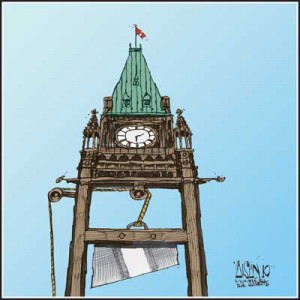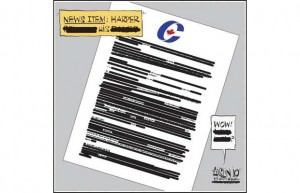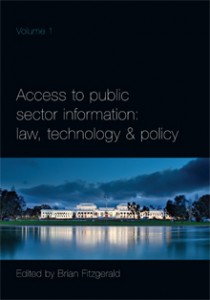The following is an article by Guest Authors Stanbury and Boyko.
By W.T. Stanbury, Professor Emeritus, University of British Columbia, and
Ernie Boyko, Adjunct Data Librarian, Carleton University Library Data Centre.
We are deeply appreciative to the retired senior official of Statistics Canada and others who provided so much detail on the Census. We understand why they wish to remain anonymous.
August 23,2010
Introduction
The Harper Government’s assertions about concerns over privacy and coercion have resulted in its decision to make the long form of the Census voluntary in 2011. The purpose of this paper is to examine the practices of Statistics Canada in relation to these concerns.
The Harper Government did not provide a news release explaining it decision when it was made public in the Canada Gazette on June 26, 2010. In the first news stories about the decision, Tony Clement, the Minister of Industry, who is responsible for Statistics Canada, and the chief spokesperson on the issue, said: .”Every MP has had complaints ..[on] the issue of coercion and too much intrusiveness” related to the long form.
In Industry Canada’s first news release on the census on July 13,2010, the Minister was quoted as follows: “The government does not think it is necessary for Canadians to provide Statistics Canada with the number of bedrooms in their home, or what time of the day they leave for work, or how long it takes them to get there. The government does not believe it is appropriate to force Canadians to divulge detailed personal information under threat of prosecution.”
PART 1 PRIVACY CONCERNS
Defining the Privacy Concerns
We suggest that for the Census, concerns about privacy are based on two things. The first is that sensitive information will become known to others who know the respondent. (Most spouses have secrets from each other, right?) The second concern is that sensitive information, despite assurances of secrecy will become known to others., and they will exploit it . Such exploitation may be pecuniary (e.g., identity theft), or it is more likely to take forms that cause psychological distress (e.g., others who know the person may have sensitive information ).
We address each of these in turn. Then we turn to the matter of coercion in Part 2.
Local Enumerator Issue
Prior to 2006, the local census enumerator who dropped off the form would get it back and edit it. It is important for Statistics Canada ( STC ) to hire people who know the area, speak the languages in use in that area etc., but there was always a risk they knew the people whose forms they reviewed. There were always alternative procedures in place if respondents had concerns, but they were not well known by the public.
Starting in 2006, Census forms were either sent back by mail or internet to a central processing site in Ottawa. If the form was completed properly and returned promptly, no local person would ever see it. During the data collection clean-up phase, forms were also completed on the telephone and face to face.
Internet Option
For the 2006 Census, the Internet option was introduced and used by just over 18% of households. There was no difference in response rates for the long form and the short form.
If a person did his/her Census form on-line and did it properly so that it would pass the edit phase, it would be handled strictly by machines. Incomplete responses were passed to a processing unit in headquarters. Telephone follow-up with the respondents was carried out only for cases that could not be resolved manually
Retention of Name and Address
The name and address of each respondent to the long form are captured and are kept in a separate file until all the evaluations and checks are complete. To evaluate the accuracy of the Census, STC carries out what is called “the reverse record check.” This requires each respondent’s name and address, but this information is kept under very strict control
Names are stored within the STC Response Database. It is used within processing for activities such as following up on questionnaires that failed edits, coverage studies, sampling for post-census surveys and tax data linkage, as well as design work and estimation for future census processing activities.
No information is ever disseminated from this database.
Secrecy Never Breached
When he testified before the Commons Industry Committee on July 27, 2010, Dr. Ivan Fellegi, head of STC from 1985 to 2008, stated, “ there isn’t a single case of any information ever reported to Statistics Canada having been released with identification of the source–that is, who reported it. Further, in 2006, “ We ordered a security audit [and hired a firm which ] specializes in ‘white hat’ hacking…to try to hack into the database to try to penetrate our security. They couldn’t.”
PART 2, THE MATTER OF COERCION
Minister Clement’s Concerns
The Minister has focused on the penalties (a maximum fine of $500,and/or imprisonment for up to three months) for refusing to complete a census form, but has not addressed the key fact that it is Parliament that has made a Census mandatory.
Response Rate and Follow-up
In practical terms, much of the feeling of coercion appears to relate to respondents who do not file the form promptly and are subject to follow-ups by STC.
A retired senior STC official states that “about 70% or so of Census forms are returned in short order. Another 20% or so will respond when given one or more reminders.The last 10% is really difficult to get. It takes time and is expensive. STC communications at this point are basically that there is a legal requirement and our job is to get a completed form from them: we will keep coming back until we get one. After the follow-ups, STC ends up with a response rate of 98% for the short form and around 93-95% for the long form. Focus group testing has shown that Canadians prefer to know up front about the legal requirement to provide information for the census.”
Contacting Respondents
Once the census forms are distributed to a household, there are only two reasons why STC staff would ever contact a household. One is if the form is not returned within a couple of weeks. The second is if the form was not completed properly and failed the edit procedure which is done by machine. A relatively high proportion of long forms completed on paper fail the edit phase ( estimated by a former official at 40%).
Edit failure for the short form is much lower. For internet responses, it was very low –as edits were built into the programs and people would be prompted to correct responses as they went. If one responds to the census correctly and in a timely fashion, the respondent will never hear from a Statistics Canada employee and only machines will read the information
Managing the Follow-up Contacts
A retired STC official states: “Many of the census complaints I received over the years related to the follow-up procedures. We hired a large temporary work force (some 25,000 across Canada) to do the work, many of them students. They were trained to be polite, told not to contact people after 9:30 PM or so, and to walk away from confrontations. A few went too far. They used threatening language, and told people they would go to jail, etc. I assume this could be viewed as coercion, but people complain about threatening communications from the Canada Revenue Agency when there is a problem with their taxes.”
The retired official continues,“ STC is obligated to make the census as complete as practicable. The communication messages do became tougher for subsequent follow-ups.. This is what I heard from the public about, not the individual questions.”
Prosecutions Policy
The retired STC official explains: “We never prosecuted all of the adamant refusals to respond. At the end of the census, we would review all of the well-documented cases, and send along to Ottawa only those where we had good documentation including a face-to face-refusal and a clear description of the person refusing. These cases were referred to the Department of Justice for review and prosecution.”
He continues, “The number of prosecutions was under 50 in 2006 , and the conviction rate was very high. I emphasize that no one was ever sent to jail over the census. In some cases, fines [ the maximum is $500 ] were imposed by the judge, but more frequently, the judge simply instructed the defendant to complete a census form.”
Summary and Discussion
Statistics Canada made important changes at the enumeration phase starting with the 2006 Census to address privacy concerns (returning forms by mail to a central office and permitting the completion of forms using the Internet). This point has not been understood.
There has never been a breach of the secrecy requirements related to the Census.
The Harper Government said that its decision to change the Census was based on complaints about “intrusiveness and coercion,” However, within the two months following the announcement of the decision, the Government had provided no data on the number of complaints. No one can find evidence of any organization lobbying for the change made by the PM.
As for coercion, in his testimony before the Commons Industry on July 27, 2010, the Minister repeatedly refused to say how many people had been imprisoned for non-compliance. Dr. Fellegi testified that it is zero since Confederation. In any event, the Minister announced on August12 that the imprisonment penalty will be removed.
It appears that privacy and coercion concerns were stoked by Conservative Party MPs such as Mike Lake, David Anderson, and Tom Lukiwiski during the Commons Industry Committee hearings on July 27.
In light of the facts concerning the additional protections instituted with the 2006 Census (described above) ,we suggest that those who insist they are fearful of the loss of privacy and coercion related to the Census have, in fact, almost nothing to be fearful about.
Trudo Lemmens argues that “privacy cannot mean that we are fully free to decide whether we will give personal information to legitimate governmental agencies. Otherwise governments could not work. Our tax system, public health care, land registration, driving licenses, the judicial system, employment benefit plans, and the governmental bureaucracy, they all require the collection of highly personal and detailed information, often with criminal sanctions attached. Yet, no reasonable person would argue that these mandatory collections violate privacy.”( The Hill Times,Aug.23,2010). So, what is about the Census that has caused the Government to invoke the privacy issue?
Since both the penalties and the content of the questionnaires are the prerogative of the Government, we wonder why they did not simply address both issues within the context its review of the census. The loss of comparability between 2006 and 2011 will leave Canadians unable to assess the effects of changes in policy brought in by the Harper government. It is quite legitimate—indeed ,highly desirable– to review the Census thoroughly, but it should have been done with the advice of user groups, and with the clear objective of maintaining the continuity of historic data to track trends.




Comments on Posts